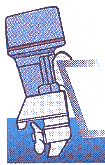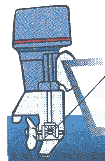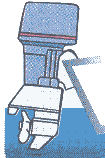Tilt and Trim: What’s the difference?
If you’re new to boating you may have heard the terms trim and tilt in relation to how your boat’s motor operates. Oftentimes tilt and trim are referred to in odd ways. It might make you think they are actual components on your outboard motor that need to be maintained. That means things like switches or buttons you can press but that’s not exactly the case. To fully understand what tilt and trim me, you need to understand the basics of how a boat operates.
Generally speaking, your boat should be parallel to the waterline. When your boat is even it runs more smoothly. No doubt you have seen some boats cutting through the water on an angle. The engine down and the bow up in the air. This might look flashy and fast. However, that’s not entirely true. You can get much better speed and efficiency with a boat on an even keel. Managing the tilt system properly will allow this to happen. It improves fuel economy and overall performance.
Trim refers to the angle that your propeller shaft is at relative to the boat. You can adjust the trim so that the angle of your engine is down. This is known as negative trim. Doing this causes the bow of your boat to drop. On the other hand you can chill the angle of your engine up or else. This is what’s known as positive trim. When you do this the bow of your boats will rise in response.
The effect of the angle of trim has more to it than simply raising and lowering the value of your boat. Let’s take a look at the three positions of trim and how they affect your boat.
Trimming In

Neutral Trimming

Trimming Out

Things to Remember
Regardless of how you trim and tilt the boat there are a few things you need to keep in mind. If you want to maintain proper control, you need to know when to trim the motor in. Also when to trim the motor out, and how it’s going to affect your control. Understanding trim and tilt means having a better time boating.
Direction
Understanding how to trim with your engine involves figuring out the directions. Until you’re used to it you might not remember which way to tilt the prop to get your desired reaction. Fortunately there’s a pretty handy way to remember things. Prop down equals bow down. Prop up equals bow up.
Pull
Remember that when you’re driving a car you’re on a two-dimensional plane. You don’t have to worry about any up or down motion. Because your prop is underwater and the trim moves up and down in the water you have that added dimension. That’s how come when you trim up the boat may start pulling to the left. And when you trim down the boat will pull to the right. This is one of the more important things to understand about tilt and trim.
Manual versus Power
Smaller boats with outboard motors will have a manual trim control. Larger boats will likely have a power tilt option. This will be a toggle switch or rocker switch on the control panel. You can either toggle up, down, or remain neutral. All work essentially the same way. However, when you are able to manually control the tilt you have more control over all. Some boaters will be dead set against power tilt and trim.
Trim Tabs
Trim tabs are stainless steel panes mounted on your boat’s transom. They are hydraulically powered and adjustable. When you use the control switch to activate them they will move up and down. Like the flaps on a plane, they alter the boat’s lift. This is done to compensate for changes in speed and water conditions.
Efficiency
When you’re new to voting it can be difficult to understand the purpose of adjusting the trim on your boat. You might think that Simply Having the chills on an even playing is good enough. After all, when your prop is levelled all of the energy and expense is used to push your boat forward. However, water can be a tricky substance to navigate. You need to worry about choppy water, for instance.
Mastering the tilt of your engine improves overall performance. This will allow you to have a greater efficiency in terms of fuel and speed. If you’re running into choppy water, you need to be able to raise the bow. When the bough is up, there is less hell in the water to produce drag. That means you can go up to a higher speed. However, this does come with risks.
You can’t allow the bow to get too high out of the water. This will actually have the reverse effect to what you want. You’ll start doing what some people refer to as porpoising. This is that bounce that is like a dolphin, or porpoise, jumping out of the water. The bow can get so high it can block your view of the water ahead of you.
If you tilt the prop too high you may start sucking in air. If it goes too low, you can actually flood the engine. You need to make sure you’re balancing between the two. That will stop your bow from ever being too high or too low for too long.
Categories: Boats












1 Comment
Karl on July 4, 2021
I have a large grandson that sits in the front. I have a pin I have to move after stopping and raising the motor to adjust the tilt-trim..it has three holes for this adjustment.. where should it be?